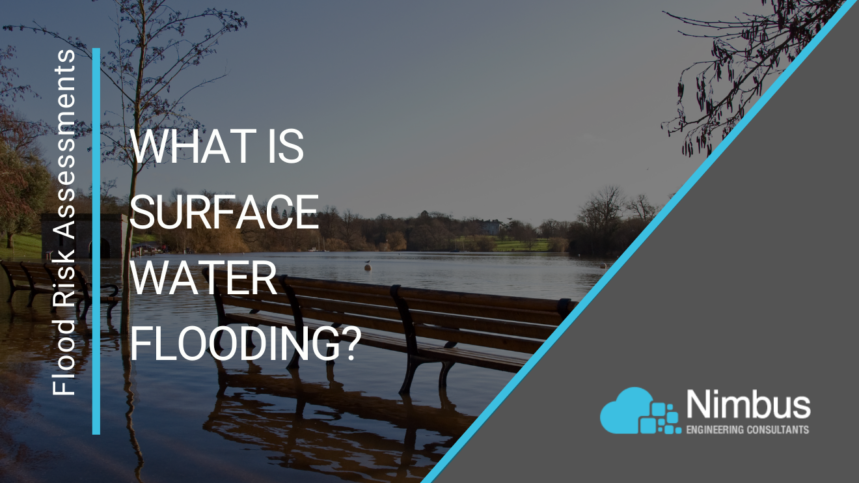Simply put, surface water flooding occurs when the volume of rainwater falling cannot drain away through existing drainage systems or by filtering into the ground. As a result, the water lies on the ground and may begin to flow – causing localised floods, which can affect your development(s).
Typically, surface water flooding is caused by the amount of rainfall and the high speed at which it hits the ground. This causes a build-up that prevents the existing drainage systems from draining it.
Surface water flood events usually have localised effects, therefore only impacting properties in close proximity to the resulting floods. In these instances, it may only affect those properties and the surrounding areas for a short period of time.
However, due to the sporadic and intense nature of these surface water flood events, the damage can be extensive and affect huge areas, being in situ for prolonged periods of time.
So we know that surface water flooding can be hugely disruptive to your new development(s).
Now let’s see how it could affect you and your future planning applications and what you can do to prepare for it.
Read on to learn more…
Which Flood Zones Does Surface Water Flooding Affect?
You may be thinking that surface water flooding only affects Flood Zones 2 & 3 and that a Flood Risk Assessment report is not required if your site does not belong to these zones.
However, surface water flooding relating to insufficient surface water drains or critical drainage problems will also affect Flood Zone 1 developments.
Critical Drainage Areas (CDA) are specified areas within Flood Zone 1 that have been identified as having subpar drainage infrastructure. These areas are at critical risk of failing during these flash floods, which may result in runoff causing a number of potential problems. In these areas, you will still be required to carry out a Flood Risk Assessment.
As you can see, even if your development is in Flood Zone 1, it may still be heavily impacted by surface water flooding, due to its inconsistent and unpredictable nature.
Fun Fact
Surface water flooding risk affects more than 3 million properties in the UK, while flooding from rivers and sea affects only 2.7 million.
These numbers may surprise you, but they highlight the need for extra vigilance in this area whilst carrying out your planning applications.

Identifying And Preventing Surface Water Flooding Risk
To check whether you are at risk from surface water flooding, you can visit the Environment Agency’s website and see their flood risk maps on gov.uk here. Then, simply navigate to the surface water section.
To further identify if your development is at risk of surface water flooding, you can contact your lead local flood authority (LLFA). Their role is to manage local flood risk, including surface water, groundwater and rivers and streams that are not classed as main rivers.
So what can you do?
There are a number of ways you can reduce surface water flood risk, including:
- Sustainable Urban Drainage Systems (SuDS)
- Natural flood management (NFM)
- Property flood resilience (PFR) measures
- Report any local highway gully, footpath or drain blockages to your County Council or Unitary Authority
On average, the damage caused by surface water flooding exceeded £300 million in recent years
DEFRA (Department for the Environment, Food and Rural Affairs) reports this number is thought to increase by around 40% by the 2050s due to the growing population and expected increase in heavy bursts of rainfall.
Whilst surface water flooding risk is something that can be monitored and reduced, it’s essential to bear in mind that one-in-six UK properties are at significant risk of flooding.
If your site is in Flood Zone 1 and you would like to find out more about our approach to Flood Risk Assessments or whether you require one for your site, reach out to a member of the Nimbus team today. We’re always happy to help.
About Nimbus Engineering
Nimbus Engineering is a dedicated team of consulting Civil Engineers with a wealth of experience in covering all aspects of Flood Risk and Drainage Design, including Sustainable Urban Drainage Systems Design (SuDS Design), Flood Risk Assessment reports (FRAs), Flood Warning and Evacuation plans (FWEPs) and Surface water management schemes, including SuDS reports,
Working with you from the planning stage through to construction, as well as providing the necessary SuDS Management and Maintenance plans, you can guarantee tailored support every step of the way.
We work closely with many Local Authorities and Lead Local Flood Authorities nationwide and are therefore aware of each of their specific requirements, especially when relating to SuDS reports and Drainage strategy reports.


